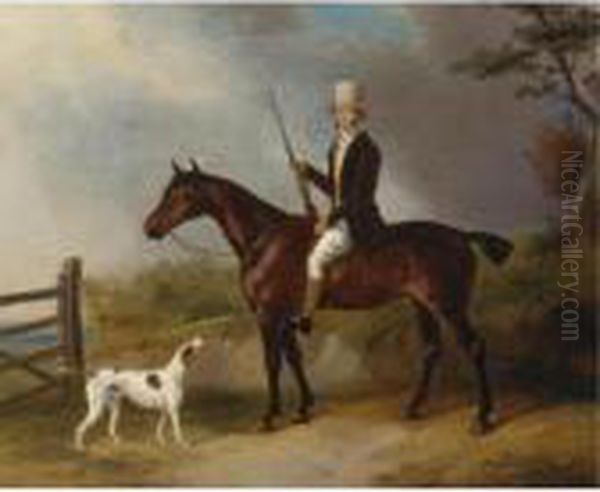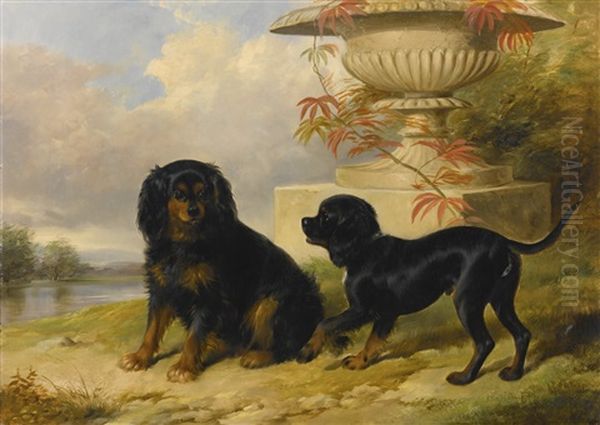William Barraud, a notable figure in nineteenth-century British art, carved a distinct niche for himself as a painter of animals, particularly horses and dogs. Active during a period of significant artistic evolution in Britain, Barraud's work reflects both the technical skill and the thematic interests prevalent in his time. His relatively short life, spanning from 1810 to 1850, was nonetheless marked by considerable artistic output and recognition within the established art institutions of London.
Huguenot Roots and Early Life
William Barraud was born in Lambeth, London, in 1810. His family background was rooted in the French Huguenot diaspora; his ancestors had sought refuge in England following the Revocation of the Edict of Nantes. This heritage connected him to a community known for its skilled artisans and professionals. His grandfather, Paul Philip Barraud, was a highly respected chronometer maker, indicating a family precedent for precision and craftsmanship, albeit in a different field.
William's father, William Francis Barraud, worked as an official in the Custom House. Initially, it seemed William might follow a similar path into civil service, as he spent some time working alongside his father. However, his inclination towards art proved stronger. Recognizing his talent and passion, he eventually left the Custom House to dedicate himself fully to painting.
Artistic Training and Development
The decision to pursue art professionally led William Barraud to seek formal training. He became a pupil of Abraham Cooper (1787-1868), a well-regarded painter known especially for his depictions of animals and battle scenes. Studying under Cooper was pivotal for Barraud, providing him with a strong foundation in the techniques required for animal portraiture and sporting subjects, genres that were increasingly popular among the British gentry and emerging middle class.
Cooper's influence likely reinforced Barraud's natural affinity for animal subjects. Barraud quickly developed a keen eye for anatomical accuracy and the ability to capture the individual character and spirit of the animals he depicted. His dedication bore fruit early on; by the age of 19, in 1829, he began exhibiting his works at the prestigious Royal Academy of Arts in London.
Specialization in Animal Painting

From the outset of his exhibiting career, William Barraud focused primarily on animal painting. His debut year at the Royal Academy saw him present works such as Triumph, a portrait of a bitch, and a painting of Betsy, a favourite dog belonging to his friend John Warde, which was exhibited under the title Mr. Warde on Blue Ruin. These early successes established his direction as an artist specializing in canine and equine subjects.
Throughout the 1830s and 1840s, Barraud continued to refine his skills and build his reputation. He became particularly admired for his portraits of horses and dogs, subjects that resonated deeply with a British society passionate about hunting, racing, and animal companionship. His paintings were noted for their realism, attention to detail, and sympathetic portrayal of the animals. Works like Pointers (1830), An old hunter (1830), A favourite cob (1834), and An old Hackney (1834) exemplify his dedication to these themes.
The Barraud Brothers' Collaboration
A significant aspect of William Barraud's career was his close artistic partnership with his younger brother, Henry Barraud (1811-1874). Henry was also a talented painter, though his focus often included figures and narrative scenes alongside animals. Around 1835, the brothers began collaborating on paintings, a partnership that would last until William's death in 1850.
Their collaborative method typically involved William painting the animal subjects, leveraging his specialized expertise, while Henry handled the human figures and often the overall composition. This division of labour allowed them to produce complex scenes combining portraiture, animal painting, and sometimes landscape elements, appealing to a broad range of patrons. Their joint works were frequently exhibited at the Royal Academy and other venues, gaining considerable acclaim.
One notable outcome of their collaboration was the publication Sketches of Figures and Animals, which showcased their combined talents. Their joint paintings often depicted scenes related to country life, sporting pursuits, or simply portraits featuring beloved pets alongside their owners. This partnership was a defining feature of William's professional life, blending familial ties with artistic synergy.
Style and Technique
William Barraud's artistic style was firmly rooted in the tradition of British realism that gained prominence during the 19th century. Influenced by his training with Abraham Cooper and likely observing the work of predecessors like George Stubbs (1724-1806) and contemporaries such as Sir Edwin Landseer (1802-1873), Barraud aimed for accurate representation. He possessed a strong understanding of animal anatomy, which lent authenticity to his depictions of horses and dogs in various poses and actions.

His technique involved careful brushwork, attention to the texture of fur and hide, and a skillful use of light and shadow to model form and create a sense of volume. Beyond mere anatomical correctness, Barraud sought to capture the 'presence' and individual character of his subjects – the alertness of a pointer, the gentle gaze of a spaniel, or the noble bearing of a hunter horse. This ability to convey personality contributed significantly to his popularity, especially among animal lovers and sportsmen.
While primarily a realist, some of his works, like The Council of horses (1830) or Gulliver meeting The Houyhnhnms (1834), drew inspiration from literature (Jonathan Swift's Gulliver's Travels), allowing for a more imaginative interpretation within his favoured animal theme. These works demonstrate a capacity to engage with narrative and allegory, adding another dimension to his oeuvre.
Exhibitions and Recognition
Throughout his career, William Barraud was a consistent exhibitor at London's major art institutions. He showed numerous works at the Royal Academy of Arts between 1829 and 1850. Additionally, his paintings were displayed at the British Institution and the Society of British Artists in Suffolk Street. Regular participation in these exhibitions was crucial for visibility, critical reception, and securing commissions in the competitive London art market.
His work found favour with collectors, particularly those involved in field sports or who wished to commission portraits of their prized animals. Paintings like Lord Methuen’s Spaniels Gipsy and Fairy (1849) are prime examples of the type of commissions he undertook. The enduring appeal of his work is evidenced by its continued presence in art collections and occasional appearance at auction houses, where pieces like Grey Weighton and Pickles still attract interest.
Wider Artistic Context
William Barraud worked during a dynamic period in British art. The early 19th century saw the legacy of Regency portraitists like Sir Thomas Lawrence (1769-1830) and Sir Henry Raeburn (1756-1823) give way to Victorian sensibilities. Landscape painting reached new heights with J.M.W. Turner (1775-1851) and John Constable (1776-1837). Animal painting itself was a well-established and respected genre, building on the foundations laid by artists such as Sawrey Gilpin (1733-1807) and the aforementioned George Stubbs.
Barraud's contemporaries in animal and sporting art included his teacher Abraham Cooper, the highly popular Sir Edwin Landseer, James Ward (1769-1859), Ben Marshall (1768-1835), and John Frederick Herring Sr. (1795-1865). While perhaps not achieving the widespread fame of Landseer, Barraud held his own within this field through his technical proficiency and the appeal of his subjects. His collaboration with his brother Henry also set him apart. The rise of institutions like the Royal Academy provided a crucial framework for artists like Barraud to build careers and reputations.
Publications and Other Collaborations
Beyond his partnership with Henry, William Barraud engaged in other collaborative ventures. In 1846, he worked with the artist and lithographer Thomas Fairland (c.1804-1852) to produce The book of animals drawn from nature. This publication, featuring lithographs based on Barraud's drawings, further disseminated his work and catered to the public interest in natural history and animal depictions. Such publications were common in the era, making art accessible to a wider audience beyond original paintings.
The Barraud Artistic Dynasty
William Barraud belonged to a family with notable artistic and technical inclinations. While his grandfather Paul Philip Barraud excelled in chronometry, William and his brother Henry established themselves as respected painters. The artistic line continued into the next generation. Henry's son, Francis Barraud (1856-1924), would achieve lasting fame, albeit posthumously, as the painter of His Master's Voice, the iconic image of the dog Nipper listening to a gramophone, which became the trademark for HMV and RCA. Although William did not live to see his nephew's most famous work, the family connection underscores a sustained engagement with the arts across generations.
Legacy and Conclusion
William Barraud's life was cut short when he died in Kensington, London, on October 1st, 1850, at the age of 40. Despite his relatively brief career, he made a significant contribution to British animal painting in the first half of the 19th century. His strength lay in his faithful and sympathetic rendering of horses and dogs, capturing both their physical likeness and their perceived character.
His collaboration with his brother Henry was a distinctive feature of his career, resulting in a body of work that successfully merged figure and animal painting. He operated successfully within the established structures of the London art world, exhibiting regularly and gaining patronage from those who shared his appreciation for animals, particularly within the context of country life and sport.
Today, William Barraud is remembered as a skilled practitioner within a strong British tradition of animal art. His works serve as valuable records of specific animals and breeds of the period, while also standing as accomplished examples of Victorian-era realism. He remains a respected name among collectors and enthusiasts of sporting art and canine and equine portraiture, a testament to his enduring skill and the timeless appeal of his chosen subjects.